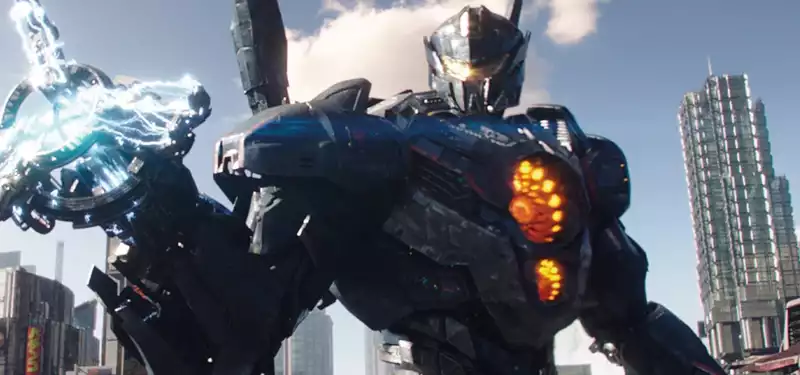Mar 29, 2018
"Pacific Rim Uprising": How Toys and Motion Capture Helped Bring Giant Robots to Life
A lot of crazy things take place in director Steven DeKnight's Pacific Rim Uprising. That's what happens when giant human-piloted Jaeger robots battle equally giant Kaiju alien creatures and other massive drone robots in crowded cities around the world.
Several techniques help vfx artists from Double Negative animate the 2,000-ton and 240-feet tall robots as convincingly as possible, including previsualization (previs), motion capture, and even staging scenes with toys.
Cartoon Brew explored the work with Pacific Rim Uprising's production visual effects supervisor and Double Negative co-founder Peter Chiang.
Of course, before any robots or creatures could be animated, the beats of each fight had to be worked out. This process began with previs. Halon, The Third Floor, and Day For Nite were the previs companies involved on Pacific Rim Uprising (other visual effects studios on the show included Atomic Fiction, Territory Studio, Blind, Turncoat Pictures, and an in-house team).
Chiang says the first stage of previs was mostly 'narrative' in nature. When he came on-board as vfx supervisor, he began breaking specific sequences down with further storyboards and even employed toys from the first Pacific Rim film directed by Guillermo del Toro as maquettes to plot out action and camera angles. “We had what we called the 'toy table,'” said Chiang. “We used that as a guide to start re-designing the sequences and making sure that everything that we were doing in visual effects was supported by what could be filmed for real.”
Principal photography was then undertaken in Australia (Sydney, Brisbane, and Gold Coast), China (Qingdao and Shanghai), with other locations for shooting including Iceland, South Korea, and Santa Monica, California. At these locations, the 240-foot tall robots were represented in several ways - by counting building floors, using weather balloons, and also by referencing the previs.
The location shoots also involved extensive photography reference and data surveys, since many of the environments would be re-crated digitally or extended in order to wreak havoc through them. Double Negative relied on Clarisse's Isotropix toolset for assembling and rendering an array of complex cg environments.
In some previous giant robot-themed films, one of the common go-to methods for selling the weight of a giant robot or creature has been to slow everything down and sell the scale that way. That's certainly a lesson Chiang says he learned from watching the first film (the robot and creature visual effects of Pacific Rim were mostly completed by Industrial Light & Magic). But for the sequel, the decision was made to approach the animation slightly differently.
“We worked it out that one seventh was the speed that everything would move at the right scale,” said Chiang. “But it would be a very slow and boring sequence if we animated it that way. So we used artistic license and cameras in order to cheat the look and feel, and keep the pace up.”
Since the Jaegers did have somewhat similar anatomy to humans, the gross movements of the robots came initially from motion capture, overseen by Double Negative animation supervisor Aaron Gilman. This gave the fights a certain martial arts feel, although each robot effectively had a different style.
One of the challenges was translating the human motion capture into a massive steel mech. “Obviously a human moves with loads of rotations,” said Chiang. “If you look at a robot's knee joint, it's not as flexible and only moves in a certain way. So a lot of that motion capture data was then edited, and certain axes taken out so that it went down to the raw fundamentals before keyframing.”
In addition, Gilman developed a technique for secondary vibrations of the robot armor and metallic pieces. This became known as 'heft and jank.' “If a robot slammed his foot,” said Chiang, “there would be a certain amount of give in the mechanical-ness of the components all moving. And then the jank would be the vibration of all those elements to give that scaled animation feel to the robots.”
A further method was employed, editorially, to help sell the speeds of the robots. For example, a robot might take a long time for its fist to swing, but by placing camera cuts in certain ways, “you could chop out all the bits that are really boring and go straight to the impact point,” noted Chiang. The action also often cuts to inside the Jaeger 'connpods,' where human operators see and control holographic surfaces and display systems (these were crafted by Territory Studio).
Meanwhile, the Kaiju creatures did not match physical human anatomy and so were all hand-animated. Muscle realization and secondary animation was aided by the use of Ziva Dynamics software that simulates movement aspects based on physically plausible rules about how muscle, fat, soft tissue, and skin operate together.
There are around 1,600 visual effects shots in Pacific Rim Uprising, many with challenging shiny robot surfaces appearing in full daylight, or with buildings being destroyed via complex destruction simulations. Chiang says he particularly enjoyed the international nature of the shoot and its post-production effort, and just the very nature of the film itself. “I mean,” said Chiang, “how bad can it get with giant robots fighting giant monsters-”




Post your comment